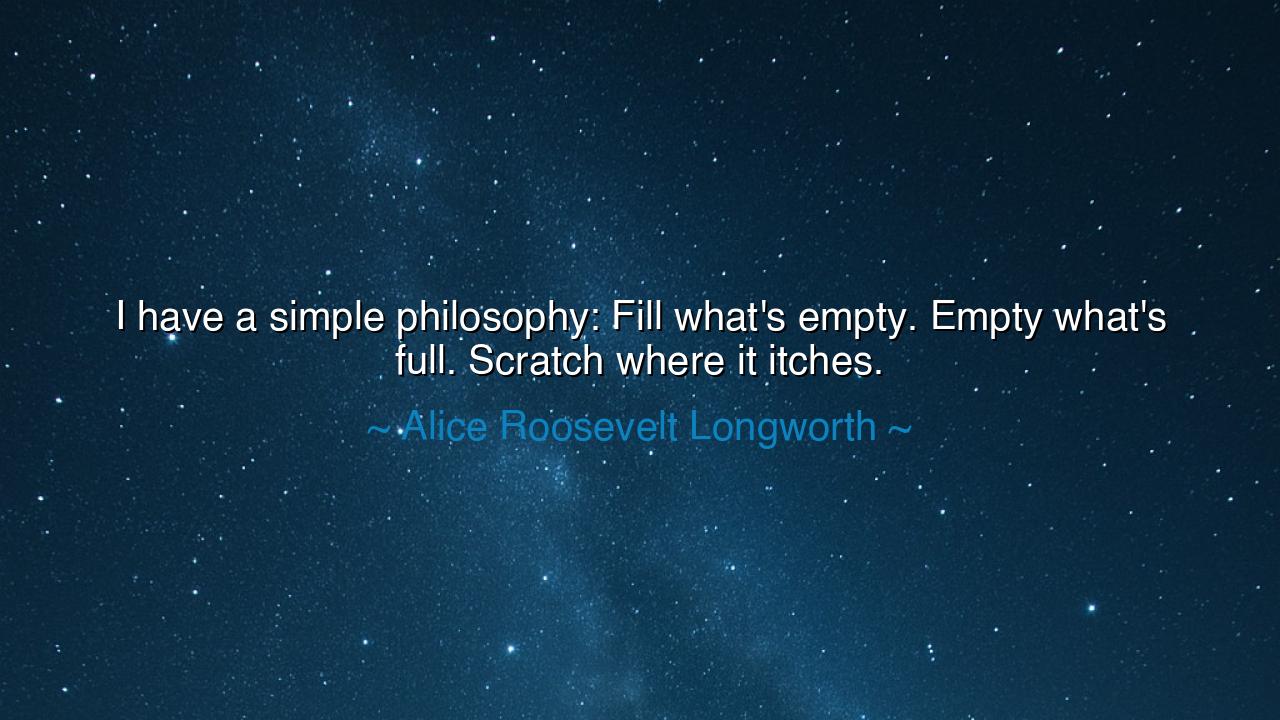
I have a simple philosophy: Fill what's empty. Empty what's full.
I have a simple philosophy: Fill what's empty. Empty what's full. Scratch where it itches.






“I have a simple philosophy: Fill what’s empty. Empty what’s full. Scratch where it itches.” — so spoke Alice Roosevelt Longworth, the fierce and witty daughter of President Theodore Roosevelt, a woman whose tongue was as sharp as her mind was brilliant. Behind her humor and playfulness lies a philosophy both earthly and profound — a creed not of lofty idealism, but of elegant simplicity. In this quip, Alice captures the eternal rhythm of life: to give where there is lack, to release where there is excess, and to tend to what calls for attention. Beneath her jesting tone lives the wisdom of balance, of instinct, and of harmony with one’s own nature.
Born into the fire of the Roosevelt legacy, Alice Roosevelt Longworth was no timid figure in the shadow of her father. She was a woman of sharp intellect, independence, and daring candor — a lioness in an age that demanded women be quiet. Her “simple philosophy” reflects her way of moving through the world: unpretentious, intuitive, and guided by common sense rather than pretense. To “fill what’s empty” is to act with compassion, to see where something — or someone — lacks nourishment, joy, or meaning, and to pour into it from the heart. It is the way of creation and restoration, of mending what is broken and reviving what has been forgotten.
Yet Alice’s philosophy is not only about generosity, but also about release. “Empty what’s full” reminds us that life requires the discipline of letting go. Just as the vessel cannot receive new wine unless the old has been poured out, so the heart cannot grow unless it releases what burdens it. Pride, resentment, greed, or even old success — all must be emptied in their time. For fullness without flow becomes stagnation, and wealth without purpose becomes rot. There is wisdom here that echoes the ancients: the Taoist teaching that water gives life by both filling and yielding, and the Stoic truth that freedom lies not in possession but in detachment.
The final part of her philosophy — “scratch where it itches” — carries the spirit of both humor and rebellion. On its surface, it is delightfully human: practical, instinctive, free from hypocrisy. Yet beneath the jest lies a deeper truth: listen to yourself. Life is full of false duties and artificial desires — the noise of what others demand. But to “scratch where it itches” is to honor the signals of one’s own soul, to address what truly needs tending, not what convention prescribes. It is the wisdom of self-awareness, the courage to act naturally and authentically, even when the world frowns upon it.
Consider the life of Leonardo da Vinci, whose restless mind forever sought to “fill what was empty.” His curiosity knew no bounds — he filled the emptiness of ignorance with discovery, sketching anatomy, painting divinity, designing flight. Yet he also “emptied what was full”: he challenged assumptions, discarded what no longer served truth, and freed his mind from the limits of tradition. And above all, Leonardo “scratched where it itched” — he followed the itch of curiosity wherever it led him, even when it defied the expectations of kings and scholars. His life, like Alice’s words, reminds us that fulfillment lies in following the honest impulse of the spirit, neither hoarding nor fearing, but living freely and responsively.
Alice Roosevelt’s words may wear the mask of jest, but their heart beats with timeless wisdom. Life, she tells us, is not a puzzle to be solved through endless worry or grand philosophy. It is a living dance of giving and releasing, of instinct and joy. To fill what’s empty is to give life purpose. To empty what’s full is to preserve peace. And to scratch where it itches is to live in harmony with one’s own nature. Those who live by this rhythm do not force life — they flow with it, like rivers that carve valleys by simply following their course.
So, dear listener, let this simple creed be your compass. When you see emptiness — in others, in your world, or in your heart — fill it with kindness, truth, or creation. When you find yourself overflowing — with anger, pride, or sorrow — empty it through forgiveness, humility, or rest. And when life itches — when the heart whispers, “Something is wrong here” — scratch it, tend to it, answer it, before it festers. Live with that honest simplicity, neither overthinking nor denying your own humanity.
For in these few playful words, Alice Roosevelt Longworth gives us a map not only for laughter, but for wisdom: that life’s grace is found in the balance between fullness and emptiness, between action and rest, between duty and desire. To live well is to know when to pour, when to release, and when to simply feel — for the soul, like the body, heals not through perfection, but through attention.






AAdministratorAdministrator
Welcome, honored guests. Please leave a comment, we will respond soon